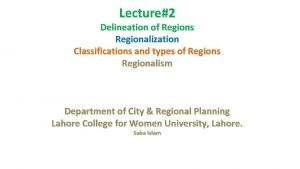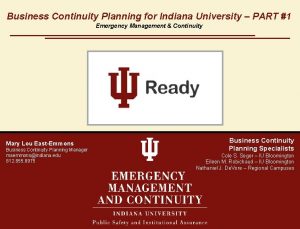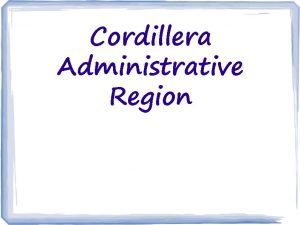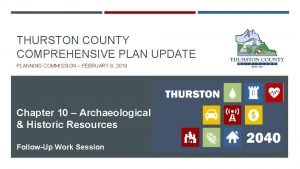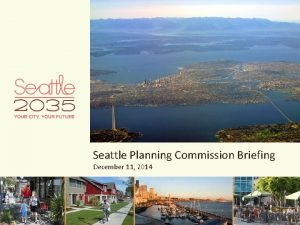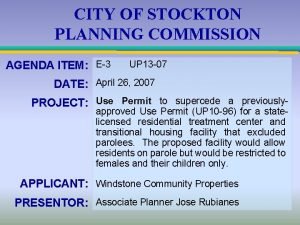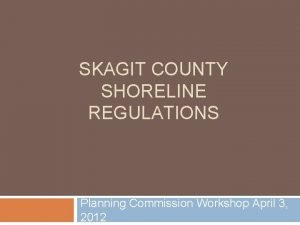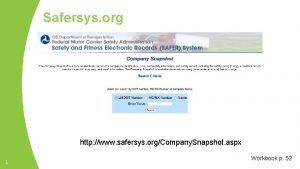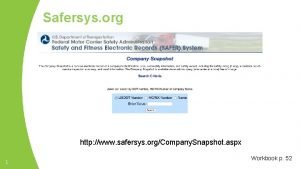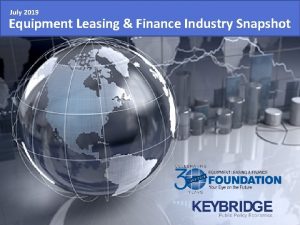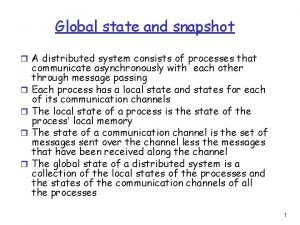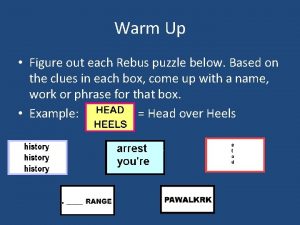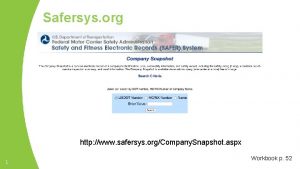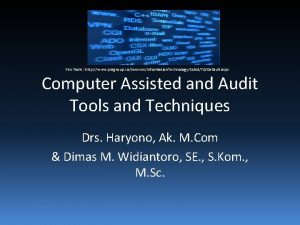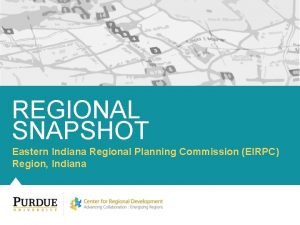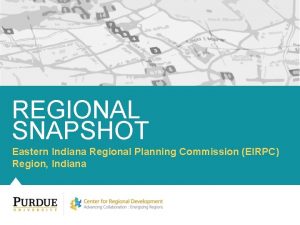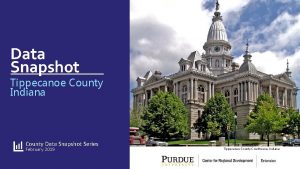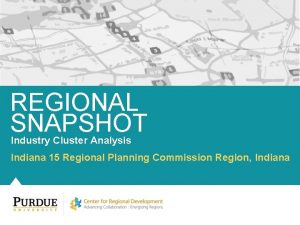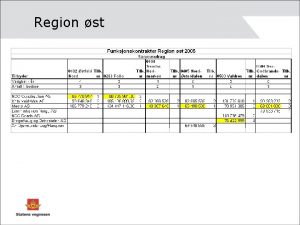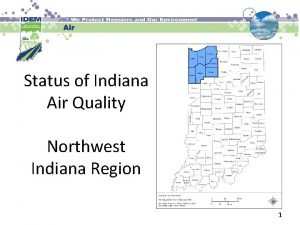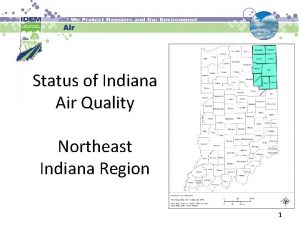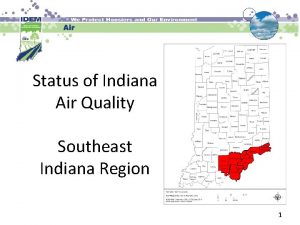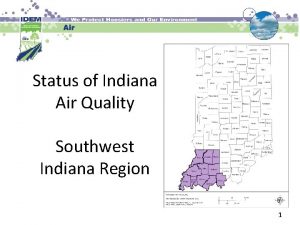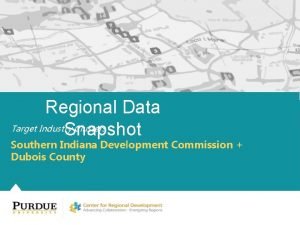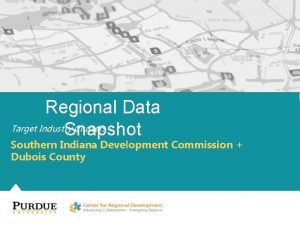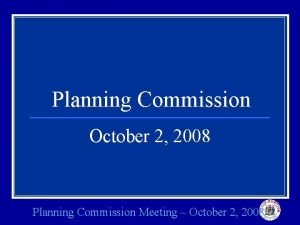REGIONAL SNAPSHOT Indiana 15 Regional Planning Commission Region
































- Slides: 32

REGIONAL SNAPSHOT Indiana 15 Regional Planning Commission Region, Indiana

Table of contents 01 02 03 Overview Demography Human capital 04 05 Labor force Industry and occupation

01 overview Indiana 15 Regional Planning Commission Region, IN What is a regional snapshot?

Overview Indiana 15 Regional Planning Commission Region The Indiana 15 Regional Planning Commission Region is comprised of six Indiana counties. I-64 passes through the central part of the region connecting to I-55 to the west and I-65 to the east. § § § Crawford Dubois Orange Perry Pike Spencer section 01 4

Overview What is a regional snapshot? What is the snapshot? This snapshot is a demographic and economic assessment of the Indiana 15 Regional Planning Commission (RPC) Region in Indiana. Using county-level data, PCRD analyzed a number of indicators to gauge the overall economic performance of the Indiana 15 RPC Region in comparison to the rest of the state. What is its purpose? The snapshot is intended to inform the region’s leaders, organizations and residents of the key attributes of the region’s population and economy. In particular, it takes stock of the region’s important assets and challenges. With such data in hand, regional leaders and organizations are in a better position to invest in the mix of strategies that will spur the growth of the economy and provide a higher quality of life for residents of the region. What are its focus areas? PCRD secured analyzed recent data from both public and private sources to generate the snapshot. In order to build a more comprehensive picture of the region, the report presents information under four key categories. § § Demography Human Capital Labor Force Industry & Occupation When appropriate or relevant, the report compares information on the region with data on the remainder of the state. By so doing, the region is better able to determine how well it is performing relative to the state on a variety of important metrics. section 01 5

02 demograph y Population change Age structure Income and poverty

Demography Population change Total population projections 6. 7% Indiana 15 RPC, IN Rest of Indiana 5, 958, 635 121, 850 2000 6, 471, 350 6, 358, 225 3. 1% 125, 577 3. 9% 1. 8% -0. 1% 125, 505 2000 -2010 -2014 6, 723, 869 2. 2% 128, 252 2014 -2020 Questions: • How does the region’s population trend compare to that of the state? • What may be some of the elements driving the trends in the region? In the state? • What strengths or challenges might these trends present? section 02 Source: 2000 & 2010 Census, 2014 Population Estimates, and 2020 Population Projection by Office of the State Demographer, Stats Indiana, http: //www. stats. indiana. edu/pop_proj/ 7

Demography Race 2000 Ethnicity Black 0. 5% Hispanics - 2000 Asian 0. 2% American Indian & Alaska Native 0. 2% Other 2. 1% [CATEGORY NAME] 0. 03% White 97. 9% Two or More Races 1. 2% 2014 Hispanics 2014 Black 1. 0% Asian 0. 4% Other 2. 7% White 97. 3% American Indian & Alaska Native, 0. 3% [CATEGORY NAME] 0. 04% Two or More Races 0. 9% section 02 Race Data Source: U. S. Census Bureau – 2000 Decennial Census and 2014 Annual Population Estimates 8

Demography Population Age Structure, 2000 A visual presentation of the age distribution of the population (in percent) section 02 Source: 2000 Decennial Census, U. S. Census Bureau 9

Demography Population Age Structure, 2014 A visual presentation of the age distribution of the population (in percent) Questions: • Is the region experiencing an aging of its population? How does this compare to the rest of the state? • Is there a sizable number of people of prime working age (20 -49 years of age) in the region? • Is the youth population (under 20 years old) growing or declining? • What are the implications of the region’s age structure for the economic development efforts of the region? section 02 Source: 2014 Population Estimates, U. S. Census Bureau 10

Demography Income and poverty Questions: 2003 Total Population in Poverty Minors (Age 0 -17) in Poverty Real Median Household Income* ($ 2013) 2008 2013 8. 6% 11. 0% 12. 4% 11. 4% 14. 8% 17. 4% $52, 934 $52, 322 $48, 217 • Is the poverty rate for individuals in the county getting better or worse? • Is poverty for minors in the county lower or higher than the overall poverty rate for all individuals? Why? • Has real median income (adjusted for inflation) improved or worsened over the 2003 to 2013 time period? What may be reasons for these changes? section 02 * Note: Regional Median Household income is the population-weighted average of median household income values across the Indiana 15 RPC Region counties. Source: U. S. Census Bureau – Small Area Income and Poverty Estimates (SAIPE) 11

03 human capital Educational attainment Patents

Human capital Educational attainment, 2013 Indiana 15 RPC Region 6% 9% Rest of Indiana 8% 5% Questions: 4% 9% 10% • What proportion of the adult population in the region has only a high school education? • How many are college graduates (bachelors degree or higher)? • How does the educational profile of the region compare to that of the rest of the state? • What are the implications of the educational profile of the region in terms of the region’s economic opportunities or workforce challenges? 15% 9% 8% 35% 17% 44% 21% No high school Associate’s degree Some high school Bachelor’s degree Graduate degree High school diploma Some college section 03 Source: 2009 -2013 American Community Survey 5 -Year Estimates 13

Human capital Patents per 10, 000 Jobs Patenting trends are an important indicator of the level of innovation in a region. 2001 -2013 From 2001 to 2013, IN 15 RPC Region counties were issued patents at a rate of 1. 58 per 10, 000 jobs, while the remaining Indiana counties garnered 3. 77 patents per 10, 000 jobs. Commercializing this innovation can lead to longterm growth for regional economies. Questions: Patents per 10, 000 residents • How does the region’s patent rate compare to that of the rest of the state? • How have rates changed over time? • What might this data suggest for the future of the region? 2001 -2013 From 2001 to 2013, 0. 88 patents per 10, 000 residents were issued in IN 15 RPC Region counties. The rest of Indiana amassed 2. 14 patents per 10, 000 residents. section 03 Source: U. S. Patent and Trademark Office, Census, BEA, and EMSI *Note: Patent origin is determined by the residence of the first-named inventor. Since a number of workers commute into the region, the number of patents produced in the IN 15 RPC Region could be high. However, among residents of the region, patent production is 14 relatively low.

04 labor force Unemployment rates Earnings per worker Source of labor for the region

Labor force Unemployment rates 12. 0% Questions: 10. 4% 9. 6% Indiana 15 RPC 5. 5% 5. 4% 5. 3% US Total 4. 6% How does the region’s unemployment rate compare to the rest of the state and nation? • How does the region’s unemployment peak and post-2009 recovery compare to the state and nation? • What might this suggest for the region’s economic future? Rest of State 9. 0% 6. 0% • 6. 2% 6. 0% 5. 5% 4. 6% 4. 2% 3. 0% 2004 2005 2006 2007 2008 2009 2010 2011 2012 2013 2014 section 04 Source: LAUS, BLS 16

Labor force Earnings per worker in 2014 Questions: • How does the region’s average earnings compare to that of the rest of the state? • What might be some driving factors for the differences? • Do these represent potential strengths or challenges for the region? Indiana 15 RPC Region $50, 000 $46, 346 $40, 000 Rest of State $40, 979 $30, 000 $20, 000 $10, 000 NOTE: Earnings include wages, salaries, supplements and earnings from partnerships and proprietorships $0 Average earnings section 04 Source: EMSI Class of Worker 2014. 4 (QCEW, non-QCEW, self-employed and extended proprietors) 17

Labor force Journey to Work 35, 644 15, 396 2013 Jobs Proportion Employed in Region 51, 040 100. 0% Employed in Region but Living Outside 15, 396 30. 2% Employed and Living in Region 35, 644 69. 8% Population Questions: • • Out-Commuters Same Work/ Home In-Commuters 22, 327 2013 Jobs Proportio n Region Residents 57, 971 100. 0% Employed Outside Region but Living in Region 22, 327 38. 5% Employed and Living in Region 35, 644 61. 5% Population How many people employed in the region actually reside outside the region? How many who live in the region commute to jobs outside the region? What are the implications for the region’s economic development efforts? section 04 Source: LEHD, OTM, U. S. Census Bureau 18

05 industry and occupation Establishments Employment by industry Cluster analysis Top occupations STEM occupations

Industry and occupation Establishments Components of Change for Establishments 2000 -2011 An establishment is a physical business location. Establishments Launched 8, 126 Establishments Closed 5, 054 Net Change 3, 072 Net Migration (Establishments moving into minus Establishments moving out of the region) Total Change Percent Change 38 3, 110 50. 3% Branches, standalones and headquarters are all considered types of establishments. Definition of Company Stages Self 2 -9 0 2 employed 10 -99 employees 4 1 3 employees 100 -499 employees 500+ employees section 05 Source: National Establishment Time Series (NETS) – 2011 Database 20

Industry and occupation Establishments Number of Establishments by Company Stages 2000 Stage Establishments 2011 Proportion Establishments Proportion Stage 0 1, 820 29. 4% 3, 173 34. 1% Stage 1 3, 387 54. 7% 5, 170 55. 6% Stage 2 873 14. 1% 854 9. 2% Stage 3 94 1. 52% 89 1. 0% Stage 4 15 0. 2% 13 0. 1% 6, 189 100% 9, 299 100. 0% Total Questions: • What stage businesses have shaped the region’s economic growth in the last 10 years? • Which ones are growing or declining the most? • Which stage of establishments are likely to shape the region’s future economic growth? section 05 Source: National Establishment Time Series (NETS) – 2011 Database 21

Industry and occupation Establishments Number of Jobs by Company Stages 2000 2011 % Change Stage 0 Stage 1 Stage 2 Stage 3 Stage 4 1, 820 12, 219 23, 099 17, 456 11, 699 3, 173 15, 902 22, 650 14, 888 10, 299 74. 3% 30. 1% -1. 9% -14. 7% -12. 0% Total 66, 293 66, 912 0. 9% Year Sales ($ 2012) by Company Stages 2000 2011 % Change Stage 0 $208, 042, 651 $212, 655, 145 2. 2% Stage 1 $1, 586, 256, 427 $1, 255, 808, 542 -20. 8% Stage 2 $2, 964, 684, 593 $2, 282, 383, 025 -23. 0% Stage 3 $2, 621, 894, 436 $2, 060, 556, 464 -21. 4% Stage 4 $1, 515, 994, 982 $1, 165, 656, 479 -23. 1% Total $8, 896, 873, 089 $6, 977, 059, 655 -21. 6% Year Questions: • What establishments are the most numerous based on company stages? • What stages have experienced the largest growth? The greatest decline? • What company stage employs the largest number of people? • What stage captures the most sales? • Which ones have experienced the greatest percentage loss over the 2000 -11 period? section 05 Source: National Establishment Time Series (NETS) – 2011 Database 22

Industry and occupation Top ten industry sector employment growth NAIC S Description 2014 Jobs 476 681 205 43% 14% 1, 651 2, 028 377 23% 14, 756 17, 638 2882 20% 16% Change (%) State Change (%) 2009 Jobs 61 Educational Services 53 Real Estate and Rental and Leasing 31 Manufacturing 81 Other Services (except Public Administration) 3, 361 3, 800 439 13% 8% 52 Finance and Insurance 1, 845 2, 085 240 13% 8% 56 Administrative and Support and Waste Management and Remediation Services 1, 745 1, 943 198 11% 23% 71 Arts, Entertainment, and Recreation 1, 526 1, 646 120 8% 8% 48 Transportation and Warehousing 2, 476 2, 596 120 5% 12% 44 Retail Trade 6, 471 6, 682 211 3% 2% 36 2% 5% 42 Wholesale Trade 2, 193 2, 229 Questions: • What regional industry sectors have seen the greatest growth? • Did they grow at the same rate as the state? • What factors are causing the growth? section 05 Source: EMSI Class of Worker 2014. 4 (QCEW, non-QCEW, self-employed and extended proprietors) 23

Industry and occupation Top nine industry sector employment decline NAIC S Description 2014 Jobs 841 732 -109 -13% -8% 3, 746 3, 513 -233 -6% 2% 551 523 -28 -5% -3% Change (%) State Change (%) 2009 Jobs 22 Utilities 23 Construction 51 Information 54 Professional, Scientific, and Technical Services 1, 571 1, 492 -79 -5% 6% 62 Health Care and Social Assistance 5, 869 5, 600 -269 -5% 8% 90 Government 7, 582 7, 265 -317 -4% -2% 21 Mining, Quarrying, and Oil and Gas Extraction 1, 130 1, 120 -1% 9% 55 Management of Companies and Enterprises 620 616 -4 -1% 11 Crop and Animal Production 3, 432 3, 420 -12 0% 1% Questions: • How does the industry sector make-up of the region compare to the rest of the state? • Which industry sectors are growing and declining the most in employment? section 05 Source: EMSI Class of Worker 2014. 4 (QCEW, non-QCEW, self-employed and extended proprietors) 24

Industry cluster analysis How to interpret cluster data results The graph’s four quadrants tell a different story for each cluster. Contains clusters that are more concentrated in the region but are declining (negative growth). These clusters typically fall into the lower quadrant as job losses cause a decline in concentration. Mature Top left (strong but declining) Transforming Contains clusters that are under-represented in the Bottom left region (low concentration) (weak and are also losing jobs. Clusters in this region may declining) indicate a gap in the workforce pipeline if local industries anticipate a future need. In general, clusters in this quadrant show a lack of competitiveness. Contains clusters that are more concentrated in the region and are growing. These clusters are strengths that help a region stand out from the competition. Small, high-growth clusters Top right can be expected to become more dominant over time. (strong and Stars advancing) Emergin g often Bottom right (weak but advancing) Contains clusters that are under-represented in the region but are growing, quickly. If growth trends continue, these clusters will eventually move into the top right quadrant. Clusters in this quadrant are considered emerging strengths for the region. section 05 Modified from: http: //www. charlestonregionaldata. com/bubble-chart-explanation / 25

Industry and occupation Distribution of clusters in the Region by quadrants section 05

Industry cluster analysis Mature Clusters Star Clusters Arts, Ent, Rec. & Visitor Industries (1. 26; 3, 531) Transportation & Logistics (1. 14; 2, 469) Level of Specialization Computer & Electronic Product Mfg. (1. 29; 523) Forest & Wood Products (10. 31; 10, 095) Primary Metal Manufacturing (8. 29; 1, 294) Transportation Equipment Mfg. (3. 68; 2, 204) Apparel & Textiles (2. 73; 1, 378) Agribusiness, Food Processing & Tech (2. 59; 5, 240) Glass & Ceramics (2. 19; 257) Manufacturing Supercluster (2. 14; 4, 949) Mining (1. 95; 396) Chemicals (1. 80; 1, 496) Advanced Materials (1. 76; 3, 589) Fabricated Metal Product Mfg. (1. 01; 563) Percent Growth in Specialization Transforming Clusters Emerging Clusters Energy(Fossil & Renewable) (0. 98; 3, 610) Defense & Security (0. 57; 1, 646) Biomed/Biotechnical (Life Science) (0. 78; 4, 164) Elec. Equip. , App. & Component Mfg. (0. 15; 23) Machinery Manufacturing (0. 76; 341) Printing & Publishing (0. 58; 681) Information Technology & Telecom. (0. 44; 1, 184) Business & Financial Services (0. 39; 3, 585) Education & Knowledge Creation (0. 34; 538) Note: Elec. Equip. , App. & Comp. Mfg. has too few jobs. section 02 NOTE: The first number after each cluster represents its location quotient while the second number represents the number of total jobs (full and part time jobs by place of work) in that cluster in the region in 2014. The clusters are sorted in decreasing order by location quotient. 27

Industry Clusters: Leakages Regional requirements, 2013 Business & Finance Manufacturing Supercluste. . . Advanced Materials ** Energy (Fossil &. . . Agribusiness & Food. . . IT & Telecommunications Biomed/Biotechnical Chemicals ** Forestry & Wood Products ** Transportation and Logistics Primary Metal ** Defense & Security Arts, Entertainment & Visit. . . Fabricated Metal ** Transportation Equipment ** Printing & Publishing Education & Knowledge. . . Computer & Electronic. . . Machinery Manufacturing Apparel & Textiles ** Mining ** Glass & Ceramics ** Electrical Equipment Satisfied in region $0 $300 $600 Millions Satisfied outside region $900 $1, 200 Note: ** shows Star clusters section 05 Source: EMSI 2014. 4 (QCEW Employees, Non-QCEW Employees, Self-Employed, and Extended Proprietors); Industry cluster definitions by PCRD 28

Industry and occupation Top five occupations in 2014 Management Occupations 8. 4% Transportation and Material Moving Occupations 8. 8% Questions: All Other Occupations 45. 1% Office and Administrative Support Occupations 9. 7% Sales and Related Occupation s 10. 7% Production Occupations 17. 3% • What are the education and skill requirements for these occupations? • Do the emerging and star clusters align with the top occupations? • What type salaries do these occupations typically provide? section 05 Source: EMSI Class of Worker 2014. 4 (QCEW, non-QCEW, self-employed and extended proprietors) 29

Industry and occupation Science, Technology, Engineering & Math Job change in STEM occupations Indiana 15 RPC, IN Rest of Indiana Questions: 113, 047 10. 3% 102, 536 1, 508 1, 485 200 9 1. 5% 201 4 Change • How do STEM jobs compare to the state? • What has been the trend of STEM jobs over time? • How important are STEM jobs to the region’s Star and Emerging clusters? *Note: STEM and STEM-related occupation definitions from BLS (2010) section 05 Source: EMSI Class of Worker 2014. 4 (QCEW, non-QCEW, self-employed and extended proprietors) 30

Report Contributors This report was prepared by the Purdue Center for Regional Development, in partnership with the Southern Rural Development Center and USDA Rural Development, in support of the Stronger Economies Together program. Report Authors Data Analysis Report Design Bo Beaulieu, Ph. D Indraneel Kumar, Ph. D Andrey Zhalnin, Ph. D Ayoung Kim Francisco Scott Tyler Wright This report was supported, in part, by grant from the USDA Rural Development through the auspices of the Southern Rural Development Center. It was produced in support of the Stronger Economies Together (SET) program. 31

For more information, please contact: The Purdue Center for Regional Development (PCRD) seeks to pioneer new ideas and strategies that contribute to regional collaboration, innovation and prosperity. Dr. Bo Beaulieu, PCRD Director: ljb@purdue. edu Or 765 -494 -7273 October 2015
 Brookens building
Brookens building What is regionalization
What is regionalization Indiana gaming commission charity gaming division
Indiana gaming commission charity gaming division Indiana retail merchant certificate renewal
Indiana retail merchant certificate renewal Recommendations of secondary education commission
Recommendations of secondary education commission Graduated commission formula
Graduated commission formula Headwaters regional development commission
Headwaters regional development commission Business continuity planning indiana
Business continuity planning indiana History of cordillera administrative region
History of cordillera administrative region Posterior scapular region
Posterior scapular region Active region and saturation region
Active region and saturation region Project preparation steps
Project preparation steps Thurston county planning commission
Thurston county planning commission Seattle planning commission
Seattle planning commission City of stockton planning department
City of stockton planning department Baton rouge planning commission
Baton rouge planning commission Skagit county setback requirements
Skagit county setback requirements Location planning analysis
Location planning analysis Southern nevada regional planning coalition
Southern nevada regional planning coalition Ssrs snapshot
Ssrs snapshot Www.safersys.org
Www.safersys.org Saferys
Saferys Affirm and noaffirm in oracle data guard
Affirm and noaffirm in oracle data guard Financialpeace.com financial snapshot
Financialpeace.com financial snapshot What is longitudinal study in psychology
What is longitudinal study in psychology Memory snapshot essay examples
Memory snapshot essay examples Memory snapshot essay examples
Memory snapshot essay examples Equipment leasing and finance industry snapshot
Equipment leasing and finance industry snapshot Distributed snapshot
Distributed snapshot Currents by hannah bottomy summary
Currents by hannah bottomy summary Implied metaphor
Implied metaphor Safersys snapshot
Safersys snapshot Safersys snapshot
Safersys snapshot

